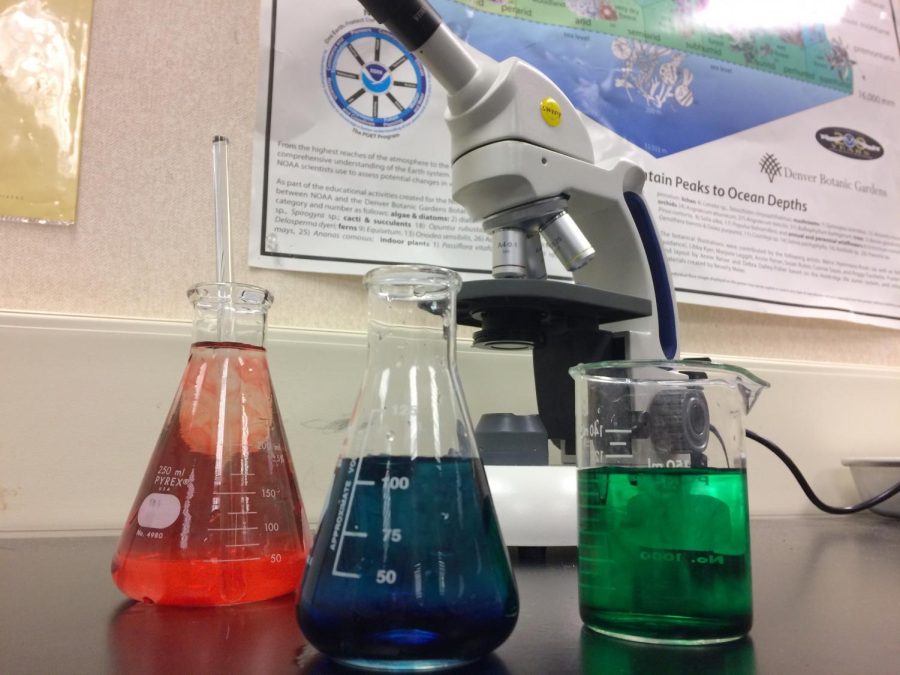Science department implements next generation standards
November 21, 2017
In September 2013, California’s State Board of Education (SBE) adopted the Next Generation Science Standards for California Public Schools, Kindergarten through Grade Twelve (CA NGSS). The new regulations were enacted to assist teachers in implementing new science curriculum framework. As a result, in the past three to four years, Lynbrook has been making changes in its science curriculum to touch upon Science and Engineering Practices and Disciplinary Core Ideas, which focus mainly on student learning styles. This school year, the science department will include more connections among different disciplines of science.
The goal of NGSS is to elevate science content standards and improve science education for all students. These standards give educators the flexibility to design students’ learning experiences that stimulate interest in science and prepare them thoroughly for college and careers. As a significant transition from previous state standards, NGSS demands a great deal of collaboration and patience among districts, schools, teachers and students.
The NGSS calls for a three-dimensional approach to K-12 science instruction. In the program, there are three distinct and equally important dimensions to learning science: Crosscutting Concepts, Science and Engineering Practices and Disciplinary Core Ideas. Crosscutting Concepts refer to connections across the four domains of science: Physical Science, Life Science, Earth and Space Science and Engineering Design. When such concepts, such as “cause and effect”, are made clear for students, students develop a more coherent and scientifically-based view of the world. The practices delve into what is meant by “inquiry” in science and the different investigations and designs that it demands. Students use Science and Engineering Practices to deepen their knowledge of Disciplinary Core Ideas and Crosscutting Concepts. Disciplinary Core Ideas (DCIs) are the key ideas that educators will be focusing on teaching to students. They are the concepts that have importance within or across multiple science or engineering disciplines. In the past few years, Lynbrook has focused primarily on meeting the NGSS of Science and Engineering Practices and Disciplinary Core Ideas. On the other hand, this year it will focusing more on integrating Crosscutting Concepts in addition to the two other categories.
“There’s some interpretation to the standards,” said Chemistry Honors and AP Chemistry teacher Lester Leung. “If you look at the standards, it’s not as clear cut stating that atoms are made of protons, neutrons and electrons. States decide how they want to interpret [the standards] and what should be taught in that state. California is great in the way we interpret the standards, we’re very inclusive of environmental science and making sure that our world is a safe place to live.”
NGSS differs from past guidelines largely in real-life application. Instead of simply memorizing concepts, students are encouraged to participate in critical thinking, argumentative writing, and applying scientific knowledge. Instead of following the same lab procedure in biology, for example, students will design their own experiments, analyze data and its effects. Furthermore, NGSS hopes to prepare students for future experiences with soft skills and more hands-on activities.
“There’s a smaller focus on knowing, and a larger focus on doing,” said Leung. “I think it’s a better way of learning. In general, there’s more application, there’s more thinking and it’s just a much deeper, more rigorous curriculum.”
Science curriculum at Lynbrook will now include earth science in physics and chemistry classes. Biology curriculum will have fewer altercations because it does not cover studies of inanimate natural objects. The inclusion of earth science in physics and chemistry curriculum mandates teachers to replace units of traditional subjects with earth science lessons. For example, Leung will be teaching his students about ocean acidification and the effects of the carbonic acid increase on the ecosystem.
“Incorporating more hands-on and application based curriculum is definitely beneficial because it reflects what the subject will entail in the future,” said junior Leslie Hwang. “I’m a bit concerned about how they’ll add more curriculum to the already very tightly packed curriculum that we’re taking. Everything’s pretty fast paced already, and adding new topics would be pressuring.”
Although the state board officially approved NGSS regulations in 2013, the FUHSD district and Lynbrook specifically have finished planning a general structure and began implementing the standards in more recent years. District-run professional development days have been implemented for teachers to receive training from district liaison staff and discuss ways to incorporate new material into current curriculum. The drastic changes add pressure onto teachers to revise and perfect curriculum during the school year.
Because the NGSS curriculum differs greatly from past years, the district is working to gradually implement it into schools. The state provided two options of doing so: a three year plan in which earth science is simply embedded into biology, chemistry and physics classes or a four-year plan where each student would take a biology class, chemistry class, physics class and a class dedicated solely to earth science. Lynbrook chose to use the three year plan because taking the four year route would eliminate the purpose of AP classes. The science department’s goal is to implement and meet all NGSS by the end of three years, in 2018.
Another reason why the program is just now being implemented is the development of the NGSS test. At the end of April this year, seniors will be taking a trial NGSS test. Teachers wanted to wait until the test structure was finalized before adjusting class curriculum accordingly. In an idea called “backwards planning,” teachers wished to see what the new state test would look like before designing classes based off of the test content.
“It’s like a roller coaster,” said chemistry teacher Jon Penner. “The reason why we’re wary about it because how long is it going to be in place? How effective is it going to be? What if you don’t implement what the state mandates? It’s going to be a long process and it won’t happen in one or even three years.”
There is no doubt the NGSS program will create change in the Lynbrook science department, in teaching styles, real-life application and curriculum. However, to what extent is uncertain. The most immediate change that will occur this year is the April state testing for all seniors and new concepts in the three main science classes.
“Students will definitely enjoy the new subjects because they’re different and contemporary. There’s not a huge concern and rush that we need to hurry and get this in,” said Penner. “What we want to do is take our time and get it right.”




































































